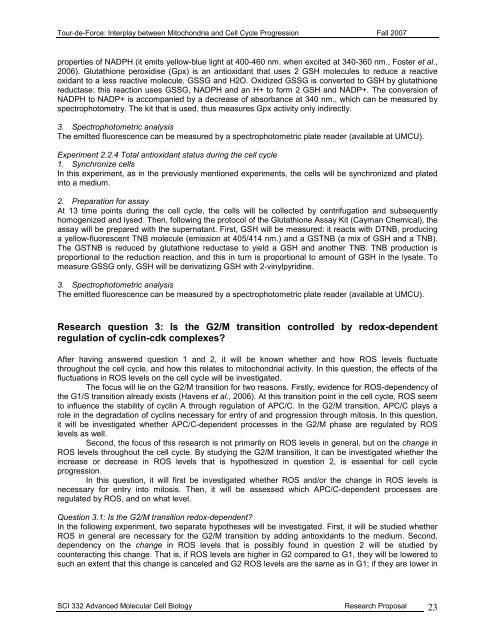Tour-de-Force
Tour-de-Force
Tour-de-Force
You also want an ePaper? Increase the reach of your titles
YUMPU automatically turns print PDFs into web optimized ePapers that Google loves.
<strong>Tour</strong>-<strong>de</strong>-<strong>Force</strong>: Interplay between Mitochondria and Cell Cycle Progression Fall 2007properties of NADPH (it emits yellow-blue light at 400-460 nm. when excited at 340-360 nm., Foster et al.,2006). Glutathione peroxidise (Gpx) is an antioxidant that uses 2 GSH molecules to reduce a reactiveoxidant to a less reactive molecule, GSSG and H2O. Oxidized GSSG is converted to GSH by glutathionereductase: this reaction uses GSSG, NADPH and an H+ to form 2 GSH and NADP+. The conversion ofNADPH to NADP+ is accompanied by a <strong>de</strong>crease of absorbance at 340 nm., which can be measured byspectrophotometry. The kit that is used, thus measures Gpx activity only indirectly.3. Spectrophotometric analysisThe emitted fluorescence can be measured by a spectrophotometric plate rea<strong>de</strong>r (available at UMCU).Experiment 2.2.4 Total antioxidant status during the cell cycle1. Synchronize cellsIn this experiment, as in the previously mentioned experiments, the cells will be synchronized and platedinto a medium.2. Preparation for assayAt 13 time points during the cell cycle, the cells will be collected by centrifugation and subsequentlyhomogenized and lysed. Then, following the protocol of the Glutathione Assay Kit (Cayman Chemical), theassay will be prepared with the supernatant. First, GSH will be measured: it reacts with DTNB, producinga yellow-fluorescent TNB molecule (emission at 405/414 nm.) and a GSTNB (a mix of GSH and a TNB).The GSTNB is reduced by glutathione reductase to yield a GSH and another TNB. TNB production isproportional to the reduction reaction, and this in turn is proportional to amount of GSH in the lysate. Tomeasure GSSG only, GSH will be <strong>de</strong>rivatizing GSH with 2-vinylpyridine.3. Spectrophotometric analysisThe emitted fluorescence can be measured by a spectrophotometric plate rea<strong>de</strong>r (available at UMCU).Research question 3: Is the G2/M transition controlled by redox-<strong>de</strong>pen<strong>de</strong>ntregulation of cyclin-cdk complexes?After having answered question 1 and 2, it will be known whether and how ROS levels fluctuatethroughout the cell cycle, and how this relates to mitochondrial activity. In this question, the effects of thefluctuations in ROS levels on the cell cycle will be investigated.The focus will lie on the G2/M transition for two reasons. Firstly, evi<strong>de</strong>nce for ROS-<strong>de</strong>pen<strong>de</strong>ncy ofthe G1/S transition already exists (Havens et al., 2006). At this transition point in the cell cycle, ROS seemto influence the stability of cyclin A through regulation of APC/C. In the G2/M transition, APC/C plays arole in the <strong>de</strong>gradation of cyclins necessary for entry of and progression through mitosis. In this question,it will be investigated whether APC/C-<strong>de</strong>pen<strong>de</strong>nt processes in the G2/M phase are regulated by ROSlevels as well.Second, the focus of this research is not primarily on ROS levels in general, but on the change inROS levels throughout the cell cycle. By studying the G2/M transition, it can be investigated whether theincrease or <strong>de</strong>crease in ROS levels that is hypothesized in question 2, is essential for cell cycleprogression.In this question, it will first be investigated whether ROS and/or the change in ROS levels isnecessary for entry into mitosis. Then, it will be assessed which APC/C-<strong>de</strong>pen<strong>de</strong>nt processes areregulated by ROS, and on what level.Question 3.1: Is the G2/M transition redox-<strong>de</strong>pen<strong>de</strong>nt?In the following experiment, two separate hypotheses will be investigated. First, it will be studied whetherROS in general are necessary for the G2/M transition by adding antioxidants to the medium. Second,<strong>de</strong>pen<strong>de</strong>ncy on the change in ROS levels that is possibly found in question 2 will be studied bycounteracting this change. That is, if ROS levels are higher in G2 compared to G1, they will be lowered tosuch an extent that this change is canceled and G2 ROS levels are the same as in G1; if they are lower inSCI 332 Advanced Molecular Cell Biology Research Proposal 23
















